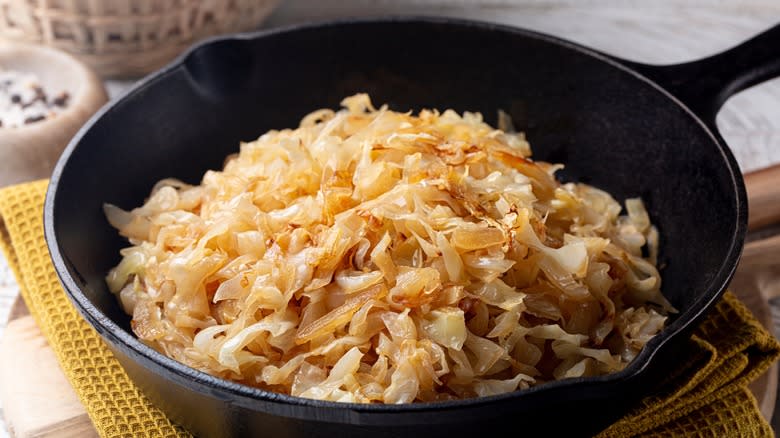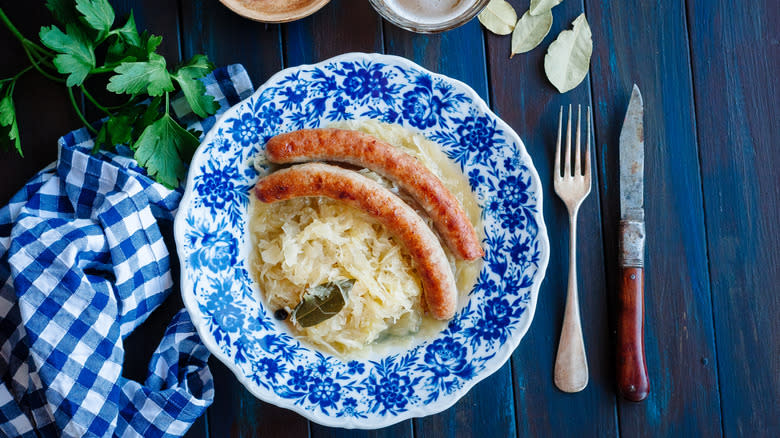Cooking Sauerkraut In Wine Unlocks A New Level Of Flavor

Hearty and surprisingly versatile, cabbage is one of the most underrated veggies. From coleslaw to spring rolls and stew, there are dozens of ways to put this leafy green to good use. Among the many ways to transform it from a crunchy head of greens, one of our very favorite cabbage dishes is sauerkraut. Briny, zesty, nutritious, and oh-so-satisfying, sauerkraut breathes life into bratwurst, hot dogs, and pastrami sandwiches. And frankly, it also makes for a pretty darn good snack on its own. Plus, while it's delicious right out of the jar, cooking this fermented cabbage delicacy in wine is a creative way to shake up your sauerkraut routine.
Though cooking sauerkraut in wine might not sound familiar to you, it's not uncommon in many parts of the world. Wine-cooked sauerkraut finds its origins in Germany, where it's aptly referred to as weinkraut, but can also be found in the French dish choucroute garnie. Wine, with its fruity, complex notes, gives sauerkraut an exciting new dimension of flavor. At the same time, its delicate sweetness evens out the intense acidity of the fermented cabbage, for a more well-rounded flavor profile. Plus, cooking kraut in wine helps tenderize and soften its firm, crunchy texture, perfect in dishes that benefit from a softer sauerkraut.
Read more: French Cooking Tricks You Need In Your Life
Types Of Wine To Use

Wine-cooked sauerkraut is a dish that even foodies new to the kitchen can hack. But even no-frills recipes need guidelines. So make sure to take note of a few tips.
The type of wine you select for cooking sauerkraut determines the shades of flavor you bring into the dish. Dry wines are best for cooking savory meals, and unless you're planning to turn sauerkraut into a dessert (please don't), steer clear from sweet wines. Dry whites -- like pinot grigio and sauvignon blanc -- are acidic, light, and typically flaunt a crisp taste with citrusy, floral, or grassy profiles that bring a refreshing brightness to sauerkraut. Dry reds like pinot noir and cabernet sauvignon are tannin-heavy and tend to have richer and more robust flavors often tinged with notes of berries, cherries, and spices that add body and depth to the kraut. Bear in mind the visual differences -- red wine will bring darker hues into the dish while white wine won't change much.
And as food and wine expert Fiona Beckett told Decanter Magazine: "If you wouldn't drink it, you shouldn't cook with it." However, you don't need to break the bank. Knowing the difference between cheap wine and value wine will help you discover an affordably priced vino with a well-founded flavor profile for your cooked sauerkraut.
Winekraut Dishes

If regular sauerkraut isn't in your meal rotation, you might not know how to use wine-cooked kraut in your favorite recipes. But with a little brainstorming action, you'll be so hungry for this booze-infused cabbage that you won't be able to wait!
Consider pairing your winekraut with herbed and charred chicken, crisp apple slices, and provolone cheese sandwiched between two crusty pieces of buttered bread. The refreshing apple slices will bolster the fruitiness of the wine, while the chicken and cheese work together to provide the sandwich with a savory richness.
Use the sauerkraut as a topping for a hearty Ukrainian-inspired Borscht soup made with beets, potatoes, garlic, and onion garnished with fresh dill and a dollop of sour cream (hot tip: here's what to do if you run out of sour cream). A combination of tangy, starchy, and creamy, flavors and textures culminate in a dish that's hearty and satisfying complimented by the uniqueness of the wine-fortified sauerkraut.
If you're feeling classic, keep things familiar and use the wine-infused sauerkraut to add brightness to bratwurst hotdogs, intricacy to Reuben sandwiches, and filling to pierogis. Winekraut also pairs well with other veggies and herbs like fennel, ginger, celery, caraway seeds, and bay leaves so don't limit yourself -- have fun exploring and discovering the many ways you can use wine-cooked sauerkraut.
Read the original article on Daily Meal.

